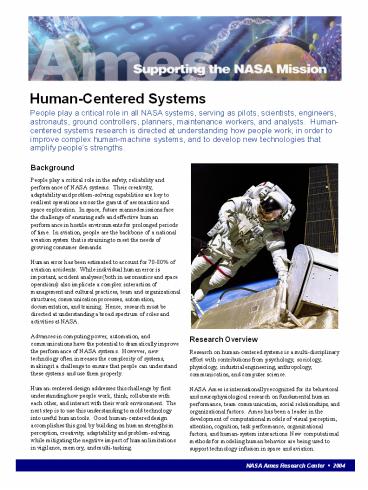Human-Centered Systems - PowerPoint PPT Presentation
Title:
Human-Centered Systems
Description:
... as new technologies for eye, gaze, and head tracking in virtual environments. ... on the aviation industry and have translated well to the Space Shuttle and other ... – PowerPoint PPT presentation
Number of Views:119
Avg rating:3.0/5.0
Title: Human-Centered Systems
1
Human-Centered Systems
People play a critical role in all NASA systems,
serving as pilots, scientists, engineers,
astronauts, ground controllers, planners,
maintenance workers, and analysts.
Human-centered systems research is directed at
understanding how people work, in order to
improve complex human-machine systems, and to
develop new technologies that amplify peoples
strengths.
Background People play a critical role in the
safety, reliability and performance of NASA
systems. Their creativity, adaptability and
problem-solving capabilities are key to resilient
operations across the gamut of aeronautics and
space exploration. In space, future manned
missions face the challenge of ensuring safe and
effective human performance in hostile
environments for prolonged periods of time. In
aviation, people are the backbone of a national
aviation system that is straining to meet the
needs of growing consumer demands. Human error
has been estimated to account for 70-80 of
aviation accidents. While individual human error
is important, accident analyses (both in
aeronautics and space operations) also implicate
a complex interaction of management and cultural
practices, team and organizational structures,
communication processes, automation,
documentation, and training. Hence, research
must be directed at understanding a broad
spectrum of roles and activities at NASA.
Advances in computing power, automation, and
communications have the potential to dramatically
improve the performance of NASA systems.
However, new technology often increases the
complexity of systems, making it a challenge to
ensure that people can understand these systems
and use them properly. Human-centered design
addresses this challenge by first understanding
how people work, think, collaborate with each
other, and interact with their work environment.
The next step is to use this understanding to
mold technology into useful human tools. Good
human-centered design accomplishes this goal by
building on human strengths in perception,
creativity, adaptability and problem-solving,
while mitigating the negative impact of human
limitations in vigilance, memory, and
multi-tasking.
Research Overview Research on human-centered
systems is a multi-disciplinary effort with
contributions from psychology, sociology,
physiology, industrial engineering, anthropology,
communication, and computer science. NASA Ames
is internationally recognized for its behavioral
and neurophysiological research on fundamental
human performance, team communication, social
relationships, and organizational factors. Ames
has been a leader in the development of
computational models of visual perception,
attention, cognition, task performance,
organizational factors, and human-system
interactions. New computational methods for
modeling human behavior are being used to support
technology infusion in space and aviation.
NASA Ames Research Center 2004
2
Human-Centered Systems
Ames researchers have developed innovative,
non-intrusive approaches to assess human
performance, such as new technologies for eye,
gaze, and head tracking in virtual environments.
Pioneering studies of workload have led to the
development of what is now the de facto, standard
subjective rating scale used worldwide. Ames has
also maintained leadership in the study of
fatigue, spatial disorientation, and perceptual
adaptation in microgravity environments.
Research on team and organizational practices
includes experimental and field studies of risk
perception and cross-cultural issues in team
decision making. It also includes ethnographic
studies and multi-agent computational models of
work systems. These approaches have produced
critical insights about circumstantial
interactions of people, tools, and organizations
that cause breakdowns in distributed cognitive
systems. Ames has also been a key player in the
development of new technologies to support
Human-Centered System Design, including
pioneering work on virtual reality and spatial
audio technologies. Research into human vision
has led to the development of widely-adopted
standards for text legibility, image quality, and
new techniques for optimizing image compression.
New concepts have been developed for flight deck
displays, air-ground automation, and
architectures for distributed multi-agent
systems. Recently developed standards for
flight-crew training and procedure design have
had an immense impact on the aviation industry
and have translated well to the Space Shuttle and
other NASA space missions. Specific advances
include new techniques for crew debriefing
streamlining documents and procedures, improving
air-ground communications, and other elements of
crew resource management. To promote aviation
safety, Ames leads an effort to systematicaly
identify precursors to accidents and incidents
through a combination of qualitative and
quantitative approaches.
Ames also leads NASA in comprehensive work system
design. The focus of this interdisciplinary
research is on design in the context of use,
which begins with a thorough understanding of the
work context and how people behave in that
context, rather than working backwards from
idealized functions to be automated. A critical
feature of this work is that it actively involves
workers in technology development, with the goal
of developing an information system that supports
the efforts of human experts to deal with
changing and uncertain situations. Research on
work system design has led to comprehensive
improvements in operations for the Mars
Exploration Rover. This research has
systematically related the design of facilities
(such as room layout), group processes (such as
communication and meeting management), and
automation (such as work flow technologies) to
facilitate collaboration and team
situation-awareness. Benefits People play a
critical role in virtually all NASA systems, both
in aeronautics and space. The future successes
of NASA missions requires that these complex
systems be designed for human use rather than
engineering convenience. Starting from a sound
scientific foundation, Ames is developing
technologies, facilities, standards, guidelines,
and procedures critical to achieving this
success. Points of Contact Patricia M.
Jones (650) 604-1345 Patricia.M.Jones_at_nasa.gov ht
tp//humanfactors.arc.nasa.gov/ William J.
Clancey (650) 604-2526 William.J.Clancey_at_nasa.gov
http//ic.arc.nasa.gov/tech/group.php?gid15ta3































